As more B2B buyers behave like consumers — expecting personalised and convenient experiences similar to those in their personal lives — manufacturers must adapt to these shifting preferences.
B2B e-commerce has made significant progress in recent years, now surpassing B2C e-commerce in global revenue by a considerable margin. The manufacturing sector is one industry that is still navigating the early phases of B2B e-commerce.
In this blog, we explore how B2B buyers are evolving, the challenges manufacturers face in meeting these new expectations, and the solutions they can implement to address them.
Changing behaviours of B2B buyers
A Statista report on B2B eCommerce provides detailed insights into the changing behaviours of B2B buyers:
The preference for self-service channels among B2B buyers has grown
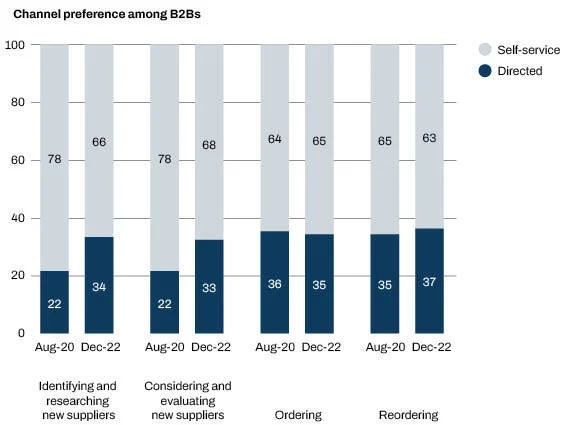
B2B buyers are increasingly using social media, texts, and mobile platforms to assess suppliers
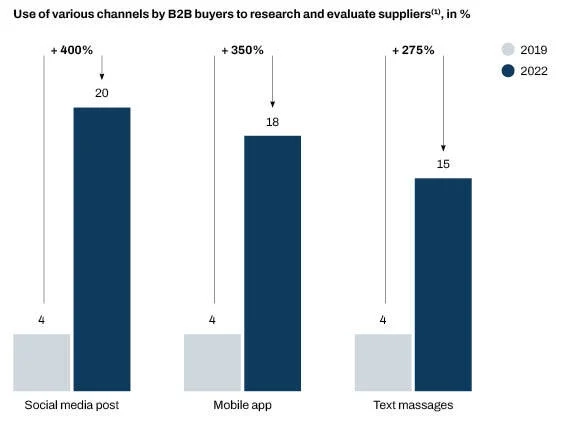
Email and live chat rank as the top two customer service touchpoints
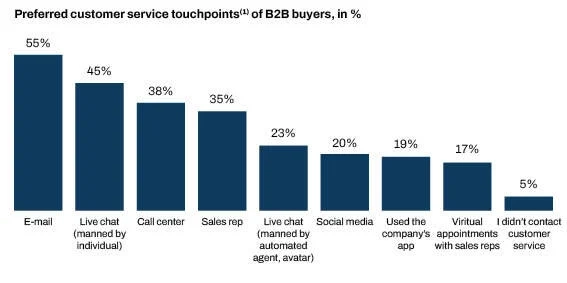
Performance guarantee is the most essential criterion for B2B buyers
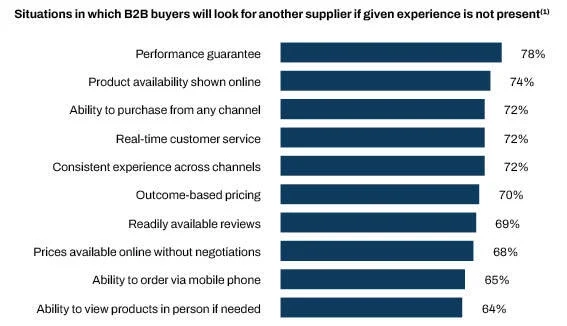
The majority of B2B buyers find online purchasing more convenient
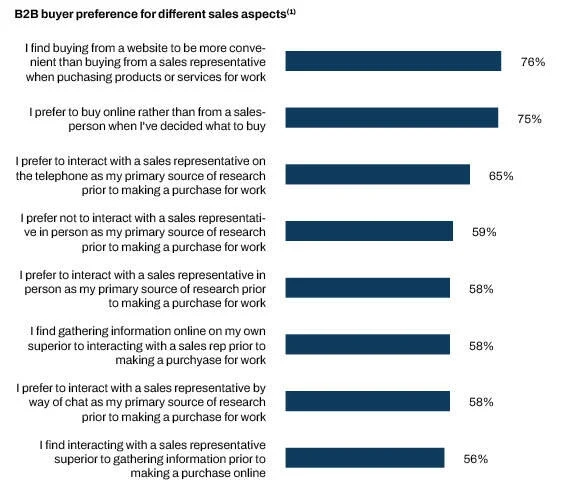
These statistics align with current trends:
- B2B buyers are seeking convenience and desire more self-autonomy to browse and purchase products at their own pace, without the interference of a sales agent. This highlights the necessity for you to develop robust self-service tools, such as customer portals, to create a seamless customer journey
- B2B buyers prefer to reach out when they are ready and want the ability to contact businesses through multiple channels. This highlights the importance of implementing a strong omnichannel strategy to meet these expectations and deliver consistent customer experiences across all platforms
- Purchasing via a website is the favoured option, which means your site must be user-friendly, well-designed, informative, accessible, and feature a smooth checkout process. This will enable you to personalize their experiences while also presenting opportunities for cross-selling or upselling
Challenges of meeting today’s B2B buyers
To meet the changing demands highlighted above, there are several strategies you can adopt. However, these don't come without their challenges. Let's take a closer look at these challenges and how you can solve them.
Lack of quality data
According to a Forrester study for Adobe, 72% of B2B customers expect fully or mostly personalised content when engaging with products and services. However, one of the primary challenges in meeting these expectations is the existence of legacy systems that lack integration. This leads to key demographic and behavioural data being siloed, making it difficult for your marketers to collect the right data for effective personalisation. Consequently, customer experiences often become disconnected or inconsistent.
An Adobe report, The Case for B2B Personalisation, highlighted this issue, revealing that respondents believe legacy software technology is the biggest barrier to achieving seamless and personalised customer experiences.
“The issue of data quality continues to be one of the biggest roadblocks to effectively analysing the prospect and customer journey. It also dramatically increases the costs of analytics projects and negatively impacts performance.”
Sameer Khan, former senior manager analytics & digital marketing at IBM, speaking to Statista’s B2B eCommerce report
Having a 360-degree view of your customers is crucial to understanding their purchasing journey. Why? Because it’s not just about selling your product; it’s about grasping your customers' needs from the start of their purchasing process so you can guide them effectively. With a comprehensive overview of your customers and their needs, you can maximize customer value in the long term.
This information should be accessible in a single view and structured format. This approach enables you to compile both historical and real-time data to understand behaviour throughout the customer journey, allowing you to make predictions, present relevant products and campaigns, and customise content based on their needs.
Building a successful data platform requires a well-defined data strategy, the right personnel and culture, efficient processes, appropriate technology, and strong data governance focused on literacy. Find out more in our guide to modern data platforms by clicking on the button below.
AI is another tool that should be integrated into your daily activities. It can enhance key business areas such as marketing through conversational chatbots, content creation, and customer journey optimisation. Despite the growing investments in AI, a recent Gartner survey revealed that only 54% of AI projects progress from the pilot phase to production, highlighting the challenges businesses face in reaching their AI goals.
Nicholas Lea-Trengrouse, Head of Business Intelligence at Columbus, highlights that many businesses rush into AI projects without proper planning, which often leads to a loss of focus on their original purpose and wasted resources.
"Taking the time at the beginning to clearly define your objectives and align each goal with tangible business outcomes will help you stay focused on the reasons behind your AI project," Nicholas explains. "By identifying areas in your business that are ready for AI integration, you can achieve early wins that will get your stakeholders on board by demonstrating that milestones are being met."
Tune in to hear more from Nicholas and other industry experts on how to achieve success with AI in our manufacturing podcast series linked below.
[CTA: Manufacturing Podcast]
Complex supply chains
Disruptions to the supply chain have become increasingly common. This is due to factors such as ongoing geopolitical conflicts, inflationary pressures, recessionary climates, and climate change-related weather events.
With B2B e-commerce businesses offering hundreds of thousands, or even millions, of products, managing inventory and vendors can be challenging. Another significant hurdle is the limited flow of real-time data throughout the supply chain. This data is vital for ensuring that customers receive the seamless shopping experience they desire, such as detailed order tracking information once they've made a purchase.
By integrating your internal and external systems, such as your ERP and CRM, you can consolidate all your customer data into a single solution. This not only enhances internal productivity and process efficiency but also improves the overall customer experience.
Watson-Marlow, a global pump manufacturer, is an impressive example of how effective integration can drive significant improvements across a business. Following the integration of a new CRM system, Watson-Marlow now has one platform that both its sales team and sales engineers can access. From here, the sales and supply teams can get a comprehensive 360-degree view of customer interactions, enabling them to better spot patterns in customer behaviour and interactions in future, as well as identify cross-selling and up-selling opportunities.
Additionally, outside sales engineers can now access all customer information they need through a mobile sales app, enabling them to send quotes, review customer records on-the-go, and track their last contact with Watson-Marlow.
"Having the CRM in the business benefits everyone, from sales engineers to the managing director," said Andrew Jones, Head of Sales Excellence & Governance at Watson-Marlow Fluid Technology Solutions, when discussing the project. "It provides individual-level visibility and a clearer, bigger picture for informed decision-making based on facts."
Interested in finding out more about Watson-Marlow’s journey? Watch the video case study below.
Success Story: Watson-Marlow Fluid Technology Solutions
Strained legacy platforms
The rapid growth of B2B e-commerce is placing considerable strain on legacy platforms. While some organisations are merely attempting to extend their ERP solutions to facilitate e-business, legacy platforms are not equipped to manage such scale. As B2B companies increasingly need to be agile and replicate B2C shopping experiences, adopting a flexible e-commerce architecture becomes essential.
A composable, flexible structure makes it easy to scale and adapt quickly to specific requirements, enhancing agility and preparing your business for future demands. This composable architecture also provides significant flexibility through open system architecture and APIs, enabling integration with other systems. It allows you to retain your existing systems during the initial stages and gradually migrate to a more modern setup. This means you can evaluate new features and adopt them at your own pace without the need for extensive changes in the short term.
Alongside a flexible e-commerce architecture is a need for an omnichannel approach that goes beyond surface level. While the term 'omnichannel' isn't anything new, its integration into B2B sales has evolved much quicker than previously anticipated. According to McKinsey, B2B customers now regularly engage with suppliers through ten or more channels, compared to just five in 2016.
While many B2B businesses acknowledge the significance of omnichannel, some fall into the trap of "omnichannel washing," recognising the principles without fully leveraging them to create genuinely engaging experiences.
To move beyond superficial omnichannel engagement, you must:
- Leverage data-driven insights: Utilising advanced analytics and AI technologies allows you to personalise interactions and tailor marketing efforts effectively to meet individual needs
- Enable a unified customer experience: Invest in technology that ensures seamlessness and brand consistency across all touchpoints. Prioritising coherence in interactions is crucial for achieving a seamless customer experience, which involves integrating both online and offline channels while maintaining brand integrity, ultimately enhancing engagement and customer loyalty
- Break down silos: Rethink organisational structures to promote cross-functional collaboration driven by a unified customer-centric vision. This will facilitate smoother interactions across channels, enhancing the overall customer experience
- Implement innovative technologies: Introducing new technologies, such as generative AI, facilitates personalised interactions and predictive capabilities, helping you meet evolving consumer expectations and ensuring continued relevance and differentiation
Another reason why many businesses are deciding to extend their legacy ERP solutions to support e-business rather than updating them is the perception that digitisation is both challenging and costly.
However, modern low-code/no-code technologies, like the Power Platform stack, can significantly enhance efficiency for B2B manufacturers without requiring significant investments. These technologies can seamlessly connect your legacy solutions into one unified ecosystem, allowing for increased automation within weeks. Find out more about how you can incorporate greater automation into your business by clicking here.
Managing organisational change
Transitioning to new technology, in theory, provides value to all stakeholders—customers, suppliers, and employees alike. However, research from McKinsey indicates that 70% of digital transformation projects fail to achieve their stated goals. This often occurs because the focus is placed on the costs associated with IT rather than the value created for end users, who are ultimately the most affected by the change.
By effectively connecting your people, technology, and business processes, you can achieve the desired outcomes. This is where collaborating with an experienced partner that has managed significant transformations in your industry can be invaluable. They should possess a proven track record of helping businesses like yours and be able to implement tried-and-tested strategies that guide you through the change while avoiding common pitfalls.
Watson-Marlow recognised that implementing technology on its own wasn't a solution. Instead, it needed to establish the right connections with its people and consider the processes that needed to come together to function effectively. Before implementing the CRM system, Watson-Marlow initiated an Explore project with Columbus, laying the groundwork for the subsequent main project and ensuring a solid foundation for successful implementation.
This involved conducting a series of workshops, supported by Columbus, with various global stakeholders. The sessions aimed to identify value and pinpoint necessary organisational changes to secure early user buy-in during the technology transition.
By taking the time to discuss and analyse the rationale behind each initiative, Watson-Marlow was able to navigate the change journey effectively and maintain sustained engagement from its stakeholders.
"Without completing the Explore project or engaging in change management and transformation within the project, none of our achievements would have been possible," said Andrew Jones, Head of Sales Excellence & Governance at Watson-Marlow Fluid Technology Solutions, when discussing the project. "We would have merely designed and implemented a CRM system without reaping any benefits."
The B2B buyer is evolving – are you keeping pace?
As the needs of B2B buyers continue to evolve, increasingly resembling B2C experiences, your business must be prepared to adapt to these changing demands. This includes offering your customers greater self-autonomy, detailed tracking and shipping information, and personalised experiences.
However, any technology you choose to implement for delivering these experiences should be accompanied by your team's involvement. By engaging them from the outset, you can alleviate their potential concerns, articulate the reasons for the changes, and help them understand the value these changes bring. When your team sees what's in it for them, they’ll feel more invested in the change process, which in turn enhances their motivation to contribute to its success.
Watson-Marlow serves as an excellent example of a manufacturer that recognised the importance of balancing people, business processes, and technology, ultimately positioning itself for success. At Columbus, we’ve helped numerous B2B manufacturers like Watson-Marlow in better connecting with its customers. For more information on how we can help your business, please contact us below.